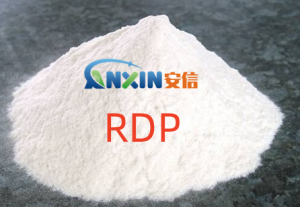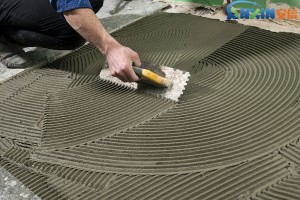In tile adhesive formulations, redispersible polymer powder (RDP) is a critical organic polymer additive. Its role directly determines the adhesive’s bonding properties, flexibility, and durability. Tile adhesive, a common dry-mix mortar product in construction, is primarily used to bond finishing materials such as ceramics, vitrified tiles, and marble. Relying solely on cement’s hydration products often fails to meet the required bond strength and durability. Therefore, the addition of RDP not only improves the physical properties of cement-based adhesives but also significantly enhances their application and long-term performance.
1. Improving Bond Strength
Tile adhesives require high initial tack and long-term bond strength to ensure secure adhesion of tiles to the substrate. During the hydration and hardening process, RDP forms a uniform organic polymer film that penetrates and wraps between cement hydration products and fillers, filling pores and strengthening interfacial bonding. The “inorganic-organic composite structure” formed with cement-based inorganic binders strengthens the bond between tiles and the substrate. This is particularly effective when attaching low-water-absorption vitrified tiles or large-sized tiles.
2. Improved Flexibility and Crack Resistance
Traditional cement mortar bond lines are relatively brittle and susceptible to cracking due to temperature fluctuations and deformation of the substrate. The polymer in RDP forms a film, imparting flexibility and elasticity to the tile adhesive. When the substrate deforms slightly, the adhesive layer buffers stress, preventing cracks. This is particularly important for outdoor applications, large-slab tiles, or floor heating systems, which are prone to thermal expansion and contraction.
3. Improved Water Resistance and Freeze-Thaw Resistance
Tile adhesives are often used in humid environments or environments with fluctuating temperatures, such as bathrooms, kitchens, and exterior facades. While pure cement-based binders can lose strength or even pulverize when exposed to water, the film-forming structure of RDP significantly reduces water penetration, enhancing waterproofing effectiveness. RDP also improves the freeze-thaw resistance of tile adhesives. Even through repeated freeze-thaw cycles, the adhesive layer maintains a stable structure and adhesion, extending the service life of tile finishes.
4. Improved Application Performance
RDP not only enhances the mechanical properties of tile adhesives but also optimizes the application experience. Its particle dispersion ensures better lubricity and water retention after mixing, extending the open time and allowing installers more time to adjust and position tiles. RDP also enhances the workability and thixotropy of tile adhesives, making them easier to apply and reducing the risk of hollowing and peeling.
5. Improved Durability and Adaptability
The long-term performance of tile adhesives depends largely on their adaptability to environmental changes. RDP imparts excellent weathering, alkali, and aging resistance, maintaining stable performance even under UV exposure, humidity fluctuations, and acidic and alkaline environments. Furthermore, RDP-modified tile adhesives are more suitable for a variety of substrates, such as concrete, gypsum board, and cement mortar, extending their application range.
6. Environmental and Energy-Saving Significance
With the development of green architecture, tile adhesives are gradually replacing traditional cement mortar installation methods. The use of RDP enables tile adhesives to achieve optimal bonding with thinner coatings, significantly reducing material consumption and creating a cleaner and more environmentally friendly construction process. This not only reduces energy consumption and costs but also aligns with the energy-saving and environmentally friendly trends of modern construction.
RDP primary role in tile adhesives is to enhance bond strength, improve flexibility and crack resistance, enhance water and freeze-thaw resistance, optimize workability, and enhance durability and environmental friendliness. By forming a composite structure with cement hydration products, it significantly improves the overall performance of tile adhesives, enabling them to meet the high-strength, large-scale, and complex construction requirements of modern buildings. Therefore, RDP has become an indispensable key component in tile adhesive formulations.
Post time: Aug-19-2025

